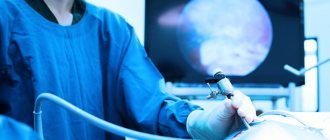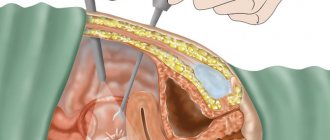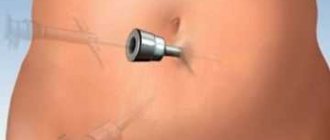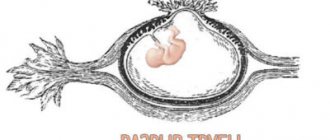Today, many married couples face the problem of infertility. There are various reasons that prevent you from fulfilling your dream of having your own children. However, modern medical technologies make it possible to combat many factors that lead to impaired reproductive function. In case of infertility, laparoscopy is one of the most effective methods for diagnosing and treating diseases and pathologies that negatively affect the female reproductive system. This is a minimally invasive surgical procedure performed under general anesthesia. The recovery period after surgery is short, which in most cases allows you to begin active planning for the next cycle. The Medline-Service clinic offers the services of experienced doctors who will help you find out the cause of infertility and prescribe a suitable treatment regimen.
Laparoscopy: concept and description of the procedure
Laparoscopy is a minimally invasive surgical method that allows manipulation using a couple of small incisions (usually they do not reach five centimeters).
Thanks to this procedure, doctors perform surgical treatment of diseases in the pelvic organs with virtually no blood loss. Laparoscopy is one of the ways to diagnose and remove uterine fibroids. Laparoscopy helps to successfully treat female diseases that no one could cure ten years ago. Today, this way you can cure endometriosis, infertility, remove cysts in the ovaries, remove adhesions, fibroids in the uterus, and some congenital defects inside the genital organs. Laparoscopy of the fallopian tubes is prescribed if obstruction is suspected.
Basic methods of treating “unexplained infertility”
Intrauterine insemination. With this method, on the days of ovulation, sperm is injected directly into the uterine cavity through a catheter. The likelihood of pregnancy increases by facilitating the penetration of sperm into the fallopian tubes. This method is quite simple and is closest to natural conception.
Photo: Method - intrauterine insemination
Stimulation of superovulation. This method involves prescribing a woman special medications that provoke the simultaneous maturation of several follicles at once. Next, you can use the method of intrauterine insemination, or try to conceive a child through normal sexual intercourse. Superovulation increases the likelihood of conception several times.
In vitro fertilization (IVF). With this method, fertilization of the egg occurs under special conditions. The embryo is grown in a special nutrient medium and then transferred to the woman’s uterus. The disadvantages of IVF are, first of all, a large drug load on the body, the likelihood of miscarriages and premature births also increases, and pregnancy is more difficult. In addition, this is a rather expensive procedure that not every family can afford.
The use of vitamins and microelements. For pregnancy to occur, both men and women must have the following vitamins in their bodies:
- Vitamin A – provides protection against infections of the genitourinary system, normalizes the menstrual cycle, and promotes the proper functioning of the endocrine system. Sources of this vitamin include foods such as carrots, spinach, parsley, liver and fish oil.
- vitamin E. With a deficiency of vitamin E, sperm production may decrease in men, and menstrual irregularities occur in women. This vitamin can also compensate for the lack of estrogen in the body. Vitamin E is found in liver, vegetable oils, milk, broccoli, nuts, seeds, and spinach.
- Vitamin C is necessary for maintaining immunity, as well as normalizing mental processes. Sources of this vitamin are citrus fruits, kiwi, berries, rose hips, sea buckthorn, peas, tomatoes, onions and many other products.
- Vitamin D helps normalize the functioning of the thyroid gland. It is found in fermented milk products and seafood, but its main source is sunlight.
The most important microelements are:
- zinc, the lack of which in a man’s body contributes to a reduction in the amount of sperm, and also causes various problems in the functioning of the genital organs. Contained in foods such as peas, parsley, turnips, beef liver, and fish.
- manganese - necessary for the normal functioning of the gonads. Manganese is found in spinach, carrots, broccoli, raisins, and walnuts.
- iodine and folic acid - these microelements are necessary for the proper development of the unborn child. The main sources of iodine are seaweed and seafood. Folic acid is found in nuts, fresh herbs, carrots, and beets.
In cases where the absence of pregnancy is associated with psychological problems in the family, consultation with a psychologist is necessary.
Indications for use
Today, a similar procedure is used for women who have:
- infertility or inability to become pregnant and bear a healthy child;
- presence of endometriosis;
- the presence of polycystic ovarian function syndrome (PCOS);
- the presence of fibroids in the uterus;
- adenomyosis;
- hyperplastic processes in the endometrium;
- sterilization process;
- Laparoscopy of the ovaries is performed when cysts with tumors form and grow in them.
Diagnostic laparoscopy is also performed; I usually resort to it when other methods do not allow an accurate diagnosis to be made.
Summing up
Fertility is a problem that plagues many women. It is not always possible to accurately determine the causes of infertility, and doctors blame the situation on the environment, pathologies occurring without symptoms, and the individual characteristics of the body. To clarify the diagnosis if you cannot get pregnant, undergo laparoscopy.
The operation is simple, performed quickly, and the recovery period lasts up to 3 weeks. There are practically no contraindications to the intervention, complications are rarely recorded, and the information obtained during the study allows us to accurately formulate why a woman cannot become pregnant. The result of laparoscopy is necessary for successful IVF, and sometimes replaces it, since during the operation the problem that prevented the conception of the fetus is eliminated.
Read
Also:
- Laparoscopy of ovarian cyst
- Fallopian tube laparoscopy
- Upland uterus and wintergreen for female infertility
- Causes and methods of treating secondary infertility in women
- How IVF is performed: stages of preparation for the procedure and possible complications
- How to treat infertility in women with folk remedies
Preparation
Such interventions are divided into: planned and emergency.
In an immediate case, preparation is not necessary, since it is necessary to save the patient's life. If we are talking about a planned operation, an examination is performed. It is also necessary to undergo a series of tests to exclude inflammatory processes. Be sure to examine the blood and find out the Rh factor.
Before the operation, a smear is certainly taken, an ECG, an ultrasound are performed, and if there are chronic ailments, an examination is carried out by a therapist who gives the go-ahead for anesthesia.
Before the operation, the surgeon explains to the patient what will happen to the person, and the anesthesiologist does an examination and finds out about the presence of allergies that prevent safe anesthesia.
If necessary, medications and psychoprophylactic training may be prescribed. If there are no prohibitions, the patient gives her consent to perform all manipulations for her treatment.
Traditional methods of treatment
Recipe No. 1
- 2 kilograms of sugar;
- 1 liter of viburnum juice;
- 250 ml water;
- mix lemon juice and sugar, 2 tbsp. Add the resulting mixture to 250 ml of water.
- take orally three times a day.
Recipe No. 2
- 1 teaspoon of dry ground calamus roots;
- 250 ml. boiling water;
- Infuse calamus roots in 250 ml of boiling water for 20 minutes;
- take every time before meals.
Recipe No. 3
- sea buckthorn juice;
- take 200 ml every day on an empty stomach;
- Course duration is 1 month.
Recipe No. 4
- 6 tbsp. l. ground valerian roots;
- pour valerian roots with water and leave for 1 hour, then boil over low heat for 20 minutes;
- remove from heat and let it brew for 5 minutes, then cool and pour into a bath of water;
- Take this bath for 2 weeks before going to bed at night.
Carrying out
If we are talking about a planned operation, it is usually performed in the morning. A couple of days before the operation, a diet is prescribed, and in the evening before the operation, intestinal cleansing is carried out.
Immediately before the procedure, at least 12 hours before, eating and drinking is prohibited. In the morning, the enema is repeated.
To avoid thrombosis before surgery, it is recommended to wear elastic bandages on the legs.
Depending on what kind of operation is performed and what kind of lesion, 3 or 4 punctures are used.
A trocar (a device for making a puncture in the abdomen and inserting an instrument) is inserted under the navel, several other devices are injected into the sides. On one trocar there is a camera to carry out control, on the other - to establish light.
Carbon dioxide is injected into the abdomen, volume and technique, an inspection is carried out in the abdomen and manipulations are performed.
In general, they last from 15 minutes to several hours. It all depends on the scope of the surgeon’s work. Anesthesia is given either by inhalation or intravenously.
As soon as the operation is completed, another examination is carried out, the blood or liquid that has accumulated during the manipulations is removed. A thorough check of the vessel clamping is carried out (for any bleeding). The gas is eliminated and the instruments are removed. Sutures are placed on the skin at the site where the trocars are inserted.
Causes of idiopathic infertility
There are a number of reasons why a doctor may diagnose idiopathic infertility in a married couple who have not had children for more than 1 year:
- no disturbances in the endocrine and reproductive systems were detected;
- regular menstruation and ovulation;
- the fallopian tubes are not clogged;
- no adhesions were detected in the pelvis;
- there are no pathologies such as fibroids, endometriosis, synechiae, polyps, hyperplasia, etc.;
- the cervix is normal;
- no disturbances in the endocrine and reproductive systems were detected;
- no sperm pathology;
- absence of sexually transmitted diseases;
- no antisperm bodies were detected;
- no similarity in antigens (HLA antigens);
- there are no genetic diseases.
If all of the above points are in order, and pregnancy does not occur, then the cause should be sought not in the physical condition, but in the psychological one, because infertility of unknown origin is not a cause, but a consequence of any disorders.
Sometimes it happens that a woman herself, without realizing it, refuses to have children, or there is no confidence in her partner, etc., in this case, you can seek help from a good psychotherapist.
Contraindications
The main prohibitions on such manipulations include contraindications in the form of:
- sepsis (blood poisoning);
- serious abnormalities in the functioning of the heart or respiratory system;
- purulent peritonitis;
- obstruction in the intestines;
- terminal states (coma, clinical death, preagonia, agony);
- recent abdominal (open) operations;
- extreme obesity (BMI over 40);
- violations of hemostasis, that is, the process of lack of normal blood clotting;
- unstable hemodynamics (sharp changes in heart rate and lack of normal blood pressure), especially that caused by bleeding due to a rupture in the fallopian tube during pregnancy outside the uterus;
- the presence of infections and inflammations;
- malignant gynecological neoplasms.
Laparoscopy results: reviews of women who dreamed of a child
The main question that women ask after laparoscopy and hysteroscopy is whether they can now get pregnant? Doctors almost always reassure their patients, but insist on strict implementation of all recommendations during the rehabilitation period.
Recovery after laparoscopy can last from several months to several years. Everything here is individual. The women's forum is filled with stories of happy mothers who at one time resorted to this operation.
Let's look at the latest reviews of 2021:
Svetlana Svyatoshina:
“After two years of unsuccessful attempts to conceive a child, my husband and I decided to go to a specialized clinic for help. The diagnosis sounded like a bolt from the blue and was disappointing: infertility! Or rather, everything was fine with my husband, but I continued my “travels” to hospitals.
After various examinations and tests, it turned out that the problem was in the location of the fallopian tubes, so the doctors recommended that I have a laparoscopy. I spent a long time choosing a medical institution where to have the operation, guided by the experience of the doctors and the availability of modern equipment in the clinic.
The matter, of course, is purely personal, but I would not recommend resorting to services in free hospitals. On day “X”, during the surgical procedure, the doctors discovered another problem, which was that I was not ovulating due to pathology not only of the tubes, but also of the ovaries. Thanks to the professionals, the long-awaited pregnancy occurred 6 months after the operation.”
Lena Viter:
“After 10 years of unsuccessful infertility treatment, I finally found a good doctor who, without thinking twice, prescribed laparoscopy. This was necessary to examine the condition of the reproductive system organs. Despite the fact that the price of the operation is quite high, in my case the costs paid off in full.
It was this check of the fallopian tubes that made it possible to see their pathology - obstruction - and eliminate it. I was in the hospital for three and a half days, after which I was sent home. The stitches were removed within a week. A little less than two years after the operation, I became a mother. And this at 36 years old.”
Numerous reviews confirm that the procedure often becomes the only salvation for women with problems conceiving a child. In addition, you come to realize how important it is to contact an experienced specialist in a timely manner, study your problem and understand its essence.
Irina Viktorovna Zhgareva’s lecture “Inflammatory diseases of the genital organs” will help restore the health of your reproductive system, protect yourself from diseases of the uterus and fallopian tubes, and also prevent the worsening of pathologies.
What to expect after laparoscopy
After the operation takes place, the patient comes to her senses while still on the surgical table, then she is transferred to the ward and she rests.
The next day, the woman wakes up, gets out of bed and takes food and water, goes to the toilet to activate blood circulation.
Then she is observed by a doctor for two or five days, the stitches are taken care of with an antiseptic, and if everything goes well, the woman is discharged. The stitches will be removed when the doctor tells you to.
Definition
Infertility of unknown origin - what is it? In a society that prioritizes family planning and professional career development, some women delay childbearing until they are 30 or more years old. As a result, they may have difficulty conceiving and may have an increased risk of miscarriage. No, this is not idiopathic infertility, it is the woman’s fault. After all, after 30 years it is very difficult to get pregnant. This fact is presented to make clear the main reason for the inability to conceive a baby.
Idiopathic infertility is a condition in which pregnancy does not occur for a long period, while all the tests of the woman and man are good. Doctors cannot determine the reason for the couple's inability to conceive a child. Perhaps it is not directly related to the reproductive system of the partners.
Unexplained infertility can be primary or secondary. In the first case, it means the inability to conceive a child. Secondary infertility means that there was a pregnancy, but at this time it does not occur.
Table. Indicators for idiopathic infertility
A diagnosis of idiopathic infertility can only be made if all tests are normal but the couple is still unable to conceive. Medicine is moving one step forward. Significant improvements in infertility treatment have made it possible for many women to become pregnant with medical assistance. Patients with pathology of the fallopian tubes, or who have had ligation, can conceive a baby using IVF. Other women have access to other methods of conceiving a child.
How is the operation performed?
To insert a laparoscope, 2–3 small incisions are usually made and, in a mode that is gentle on the body, internal organs are examined, various tumors are removed, or tissue is taken for a biopsy.
This allows patients to significantly reduce recovery after surgery (up to 5-7 days in the hospital), avoid scars, postoperative pain, and reduce the likelihood of adhesions. In addition, with this method of surgery, the surgeon has the opportunity to view various body cavities from different angles and magnification, which increases the chances of detecting tumors at an early stage of their development.
Reviews about the operation
Reviews from patients who have undergone laparoscopy are most often positive. As practice shows, the operation itself is absolutely painless, thanks to general anesthesia. After waking up, some patients complain of discomfort from the inserted catheter, constant elevated body temperature, and pain throughout the body. There are also unpleasant sensations from punctures in the abdominal cavity and the action of gas, which can create painful sensations in the shoulders and back of the head.
In the first days, the patient is prescribed pain relief, so usually this period is tolerated quite easily, especially when compared with abdominal operations.
Many patients experience vaginal discharge a few days after surgery, but not of the menstrual type. In most cases they are scarce and short-lived. In the absence of postoperative complications, discharge from the hospital is possible on the 5th day of treatment. Necessary drug treatment is prescribed on an outpatient basis.











